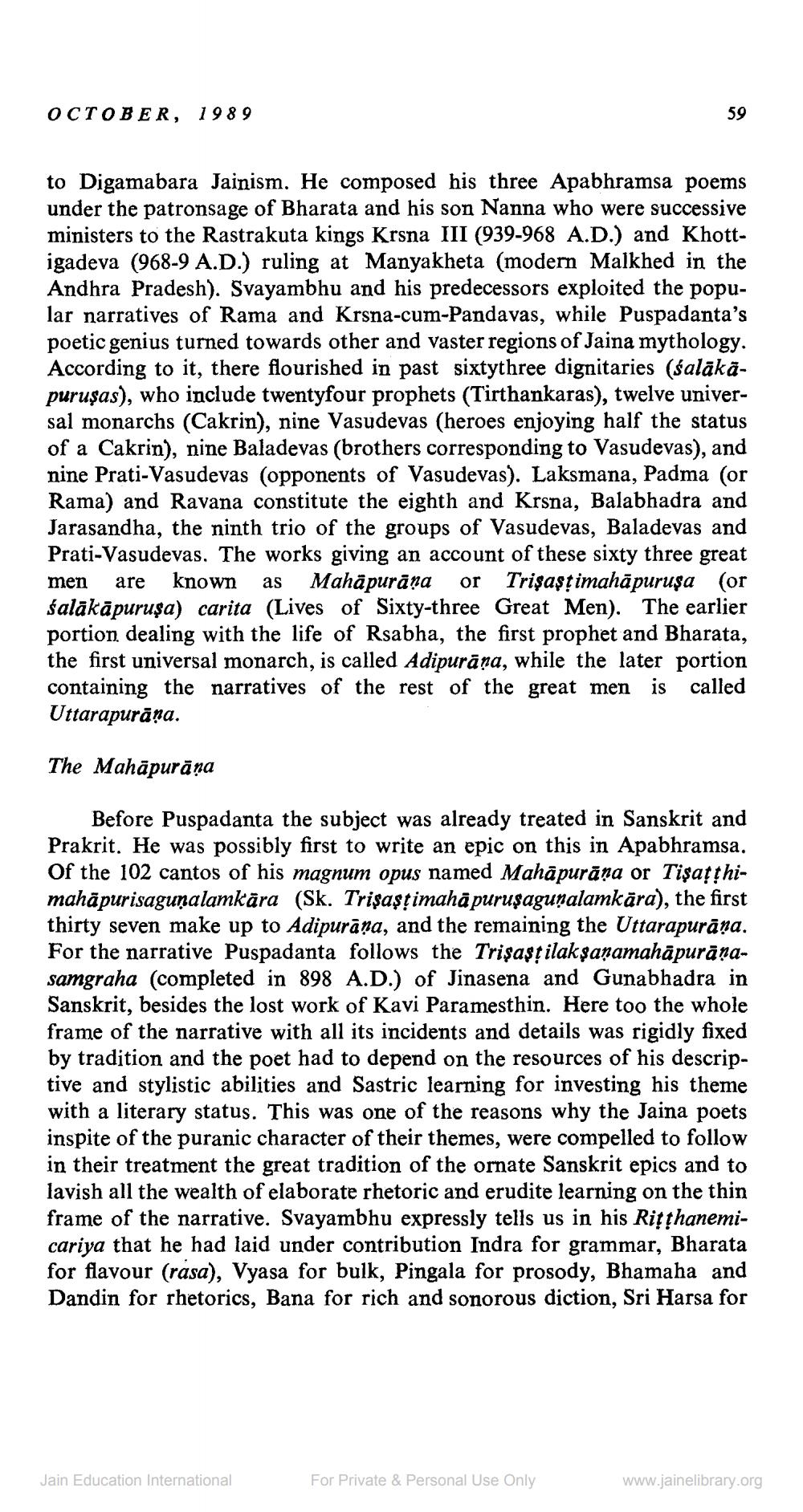________________
OCTOBER, 1989
to Digamabara Jainism. He composed his three Apabhramsa poems under the patronsage of Bharata and his son Nanna who were successive ministers to the Rastrakuta kings Krsna III (939-968 A.D.) and Khottigadeva (968-9 A.D.) ruling at Manyakheta (modern Malkhed in the Andhra Pradesh). Svayambhu and his predecessors exploited the popular narratives of Rama and Krsna-cum-Pandavas, while Puspadanta's poetic genius turned towards other and vaster regions of Jaina mythology. According to it, there flourished in past sixtythree dignitaries (salākāpurusas), who include twentyfour prophets (Tirthankaras), twelve universal monarchs (Cakrin), nine Vasudevas (heroes enjoying half the status of a Cakrin), nine Baladevas (brothers corresponding to Vasudevas), and nine Prati-Vasudevas (opponents of Vasudevas). Laksmana, Padma (or Rama) and Ravana constitute the eighth and Krsna, Balabhadra and Jarasandha, the ninth trio of the groups of Vasudevas, Baladevas and Prati-Vasudevas. The works giving an account of these sixty three great are known as Mahāpurāṇa or Trişaşṭimahāpuruşa (or salākāpuruşa) carita (Lives of Sixty-three Great Men). The earlier portion dealing with the life of Rsabha, the first prophet and Bharata, the first universal monarch, is called Adipurāṇa, while the later portion containing the narratives of the rest of the great men is called Uttarapurāṇa.
men
59
The Mahapuraṇa
Before Puspadanta the subject was already treated in Sanskrit and Prakrit. He was possibly first to write an epic on this in Apabhramsa. Of the 102 cantos of his magnum opus named Mahāpurāṇa or Tişaṭṭhimahāpurisaguṇalamkāra (Sk. Trişaṣṭimahāpuruṣaguṇalamkāra), the first thirty seven make up to Adipurāṇa, and the remaining the Uttarapurāṇa. For the narrative Puspadanta follows the Trişaṣṭilakṣaṇamahāpurāṇasamgraha (completed in 898 A.D.) of Jinasena and Gunabhadra in Sanskrit, besides the lost work of Kavi Paramesthin. Here too the whole frame of the narrative with all its incidents and details was rigidly fixed by tradition and the poet had to depend on the resources of his descriptive and stylistic abilities and Sastric learning for investing his theme with a literary status. This was one of the reasons why the Jaina poets inspite of the puranic character of their themes, were compelled to follow in their treatment the great tradition of the ornate Sanskrit epics and to lavish all the wealth of elaborate rhetoric and erudite learning on the thin frame of the narrative. Svayambhu expressly tells us in his Riṭṭhanemicariya that he had laid under contribution Indra for grammar, Bharata for flavour (rasa), Vyasa for bulk, Pingala for prosody, Bhamaha and Dandin for rhetorics, Bana for rich and sonorous diction, Sri Harsa for
Jain Education International
For Private & Personal Use Only
www.jainelibrary.org




